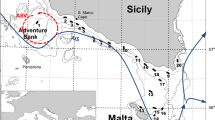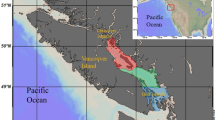Abstract
Relationships between chlorophyll a content of the water, the shoreline-length: water area ratio and the annual total fish yield as catch per unit effort (CUE: kg ha−1 100 h−1 as annual mean values) have been calculated by multivariable regression. The determination coefficient (r 2 = 0.913) showed a significant dependence of fish yield on morphometry of different lake areas. Accordingly, fish carrying capacity of the open water areas, calculated from chlorophyll a content and S/A, ranged from 12 to 34%, but that of the littoral zone between 66 and 88%. These findings have also been supported by echo-sounding records of the horizontal distribution of fish.
Bream (Abramis brama L.) contributes the majority (70–80%) of fish stock and yield. Its food mainly consists of zooplankton and benthic invertebrates in ratios that are widely variable with season and depend on the age of fish. Average daily food consumption of individuals (age group 3 + and over) varies between 2 and 5 g. Bream consumes two- to three-times more food in the SW basin than in the NE one. This means that the present stocks inhabiting areas from NE to SW consume annually 13249–20085 t yr−1 of food. According to estimated calorific values, the annual energy consumption of local populations along the longitudinal axis of the lake varies between 93 and 141 kJ m−2 yr−1. The efficiency of energy transfer from primary producers to fish is low and varies from 0.04 to 0.1%.
Similar content being viewed by others
References
Biró, P., 1973. The food of pike-perch (Lucioperca lucioperca L.) in Lake Balaton. Annal. Biol. Tihany 40: 159–183.
Biró, P., 1974. Observations on the food of eel (Anguilla anguilla L.) in Lake Balaton. Annal. Biol. Tihany 41: 133–151.
Biró, P., 1977. Effects of exploitation, introductions and eutrophication on percids in Lake Balaton. J. Fish. Res. Bd Can. 34: 1678–1683.
Biró, P., 1983. On the dynamics of fish populations in Lake Balaton. Rocz. nauk. Roln. Ser. H. 100z. 3: 55–64.
Biró, P., 1984. Lake Balaton: a shallow Pannonian water in the Carpathian Basin. In: Taub, F. B. (ed.), Ecosystems of the world. 29, Lakes and reservoirs, 231–245. Elsevier Sci. Publ. Amsterdam.
Biró, P., 1985. Dynamics of pikeperch, Stizostedion lucioperca (L.) in Lake Balaton. Int. Revue ges. Hydrobiol. 70: 471–490.
Biró, P., S. E. Sadek & G. Paulovits (MS). The food of bream, Abramis brama L., in two outside basins of different trophic state of Lake Balaton. 21 pp.
Biró, P. & L. Vörös, 1982. Relationships between phytoplankton and fish yields in Lake Balaton. Hydrobiologia 97: 3–7.
Biró, P. & L. Vörös, 1988. Relationship between the yield of bream, Abramis brama L., chlorophyll-a concentration and shore-length: water area ratio in Lake Balaton, Hungary.Aquacult. Fish. Managem. 19: 53–61.
Dévai, Gy. &J. Moldován, 1983. An attempt to trace eutrophication in a shallow lake (Balaton, Hungary) using chironomids. Hydrobiologia 103: 169–175.
Herzig, A., 1979. The zooplankton of the open lake. In: Löfller, H. (ed.), Neusiedlersee: the limnology of a shallow lake in central Europe. Dr. W. Junk b.v. Publ., The Hague - Boston - London: 281–335.
Herodek, S., 1977. Recent results of phytoplankton research in Lake Balaton. Annal. Biol. Tihany 44: 181–198.
Herodek, S., K. Györe & A. Zsigri (MS). A fehér busa telepités hatása a Balaton vizminöségére és élövilágára. Haltenyésztési Kutató Intézet (Szarvas). Mimeo, 10 pp.
Hunt, B. P., 1960. Digestion rate and food consumption of Florida gar, warmouth and large mouth bass. Trans. am. Fish. Soc. 89: 206–210.
Le Cren, E. D. & R. H. Lowe-McConnell (eds), 1980. The functioning of freshwater ecosystems. IBP Handbook No. 22, Cambridge University Press, 588 pp.
Oláh, J., E. O.-Tóth & L. Tóth, 1977. A Balaton foszfor anyagcseréje. Magy. Tud. Akad. Biol. Tud. Oszt. Közl. 20: 111–139.
Paulovits, G. & P. Biró (MS). A Balatonba telepitett fehér busa tavon belüli megoszlásának és vándorlásának vizsgálata. 31 pp.
Ponyi, J. E., I. Tátrai & A. Frankó, 1983. Quantitative studies on Chironomidae and Oligochaeta in the benthos of Lake Balaton. Arch. Hydrobiol. 97: 196–207.
Tátrai, I. & J. Ponyi, 1976. On the food of pike-perch fry (Stizostedion lucioperca L.) in Lake Balaton in 1970. Annal. Biol. Tihany 43: 93–104.
Tóth, J. & P. Biró, 1984. Exotic fish species acclimatized in Hungarian natural waters. FAO/EIFAC Techn. Papers 42 (Suppl.) 2: 550–554.
Vörös, L., 1982. Quantitative and structural change of phytoplankton in Lake Balaton between 1965–1978. Aquacultura Hungariaa (Szarvas) 3: 137–144.
Vörös, L., É. Vizkelety, F. Tóth & J. Németh, 1983. Trofitás vizsgálatok a Balaton Keszthelyi medencéjében. Hidrológiai Közlöny 62: 390–395.
Vörös, L., (MS). The importance of picoplankton in Lake Balaton. 12 pp.
Zalewski, M., P. Biró, M. Przybilski, I. Tátrai & P. Frankiewicz (MS). The structure of fish communities in streams of north part of the catchment area of Lake Balaton. 16 pp.
Zánkai, P. N. & J. E. Ponyi, 1986. Consumption, density and feeding of crustacean zooplankton community in a shallow, temperate lake (Lake Balaton, Hungary). Hydrobiologia 135: 131–147.
Winberg, G. G. (ed.), 1971. Symbols, units and conversion factors in studies of freshwater productivity. London: IBP Central Office, 23 pp.
Author information
Authors and Affiliations
Rights and permissions
About this article
Cite this article
Biró, P., Vörös, L. Trophic relationships between primary producers and fish yields in Lake Balaton. Hydrobiologia 191, 213–221 (1990). https://doi.org/10.1007/BF00026054
Issue Date:
DOI: https://doi.org/10.1007/BF00026054




